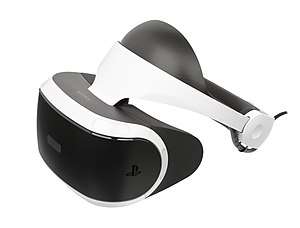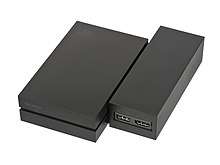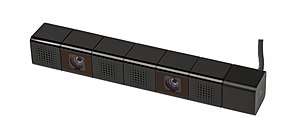PlayStation VR
 | |
| Also known as | Project Morpheus (code name) |
|---|---|
| Developer | Sony Interactive Entertainment |
| Manufacturer | Sony |
| Product family | PlayStation |
| Type | Virtual reality headset |
| Release date | October 13, 2016[1] |
| Introductory price | |
| Units sold | 3 million (As of 16 August 2018)[2] |
| Display | 5.7" OLED, 100° field of view. |
| Graphics | 1080p RGB (960 × 1080 per eye; 90–120Hz refresh rate)"[1] |
| Sound | 3D audio through headphone jack, and available microphone input |
| Input | Positional tracking with 9 LEDs via PlayStation Camera |
| Controller input |
|
| Camera | PlayStation Camera |
| Touchpad | None |
| Weight | 610 grams (21 ounces) |
| Website | Official website |
The PlayStation VR, known by the codename Project Morpheus during development, is a virtual reality headset developed by Sony Interactive Entertainment,[3] which was released in October 2016.[1]
It was designed to be fully functional with the PlayStation 4 home video game console. In certain games and demos for the VR, the player wearing the headset acts separately from other players without the headset. The PlayStation VR system can output a picture to both the PlayStation VR headset and a television simultaneously, with the television either mirroring the picture displayed on the headset, or displaying a separate image for competitive or cooperative gameplay. PlayStation VR works with either the standard DualShock 4 controller or the PlayStation Move controllers.[4]
The PlayStation VR has a 5.7 inch OLED panel, with a display resolution of 1080p.[5][6] The headset also has a processor box which enables the Social Screen video output to the television, as well as process the 3D audio effect, and uses a 3.5mm headphone jack.[5][7] The headset also has nine positional LEDs on its surface for the PlayStation Camera to track 360 degree head movement.[5][8]
As of August 16, 2018, PlayStation VR has sold-through over 3 million units worldwide, along with 21.9 million games and experiences.[9]
History
Sony's interest in head-mounted technology dates back to the 1990s. Its first commercial unit, the Glasstron, was released in 1997.[10] One application of this technology was in the game MechWarrior 2, which permitted users of the Glasstron or Virtual I/O's iGlasses to adopt a visual perspective from inside the cockpit of the craft, using their own eyes as visual and seeing the battlefield through their craft's own cockpit.[11]
In early 2014, Sony Computer Entertainment research and development engineer Anton Mikhailov said his team had been working on Project Morpheus for more than three years. According to Mikhailov, the PlayStation 3 Move peripheral, itself revealed in June 2009, was designed with unspecified, future head-mounted technology in mind. "We specced it and built it to be a VR controller, even though VR wasn't a commodity. As engineers, we just said it was the right thing to do. At the time, we didn't have a consumer-grade project that we could work on, but it was definitely designed with that vision in mind."[12] Shuhei Yoshida, the president of Sony's worldwide studios, also said the project started as "grassroots" activity among engineers and programmers, which came into focus in 2010 once the Move controller had been released.[13] Sony also went on record to say it is mandatory for all games to have no less than 60 frames per second at all times.[14]
Project Morpheus was first announced at The 2014 Game Developers Conference. Sony Computer Entertainment Worldwide Studios president Shuhei Yoshida introduced the device on March 18, 2014 and stated Project Morpheus was "the next innovation from PlayStation that will [shape] the future of games."[15]
On September 15, 2015, it was announced that Project Morpheus would be officially named PlayStation VR.[16] Later in 2015, Sony acquired SoftKinetic, a tech startup whose focus includes visual depth-sensing gesture recognition, for an undisclosed amount.[17]
On October 13, 2016, Sony released the PlayStation VR with the price of $399 in the US, €399 in Europe, £349 in the UK, and ¥44,980 in Japan.[18][19]
Hardware



The prototype revealed at GDC'15 included an OLED 1920 × 1080 pixel display (providing 960 × 1080 pixels resolution per eye) with an RGB subpixel matrix,[6] and is capable of displaying content at 120fps.[1] It features an FOV of 100°, 6DOF head-tracking, stereoscopic 3D, and unwarped output to a TV, either for others to view what the headset wearer sees, or a separate display to compete against the headset user using a standard PS4 controller.[20]
In September 2015 it was revealed the headset would have three rendering modes for developers to choose from: native 90 Hz, native 120 Hz, and a mode where gameplay running at 60 Hz would be displayed at 120 Hz using a motion interpolation technique called asynchronous reprojection.[21] The interpolation would be achieved with little system resources and a small latency of under 18 milliseconds. The technique would also be utilised in the native 120 Hz mode to ensure consistent framerate.[22] According to a Sony representative the company expects the interpolated 120 Hz mode to be a popular choice for games.[21]
PlayStation VR games can send different perspectives to the headset and television. Shuhei Yoshida, president of SIE Worldwide Studios, explained in regards to a demo by SIE Japan Studio, Monster Escape (in which four players playing off the TV must evade a monster controlled by a player using the headset), that this ability allowed VR to become an asymmetric "social experience", similarly citing the existing game Keep Talking and Nobody Explodes as another example of a VR-compatible game that emphasizes interaction.[23]
In October 2017, Sony released the CUH-ZVR2 model of the PlayStation VR headset which included minor changes, like a slimmer, more streamlined connection cable with different connectors from the CUH-ZVR1 model, and integrated stereo headphones. The newer Processor Unit also supports HDR video pass through.[24]
Games and content
In March 2016, Sony said there were 230 developers actively working on content for PSVR, with 50 titles available by the end of the year.[25]
Existing, non-VR games can be played within PlayStation VR via "Cinematic Mode", which renders the content on a simulated projection screen in a 3D space. The mode has three screen size options, ranging up to 226 inches (18.8 ft) in virtual size. PlayStation VR also supports the display of 360-degree photos and video.[26] Other features, such as Share Play and Live from PlayStation, are also compatible within the headset.[27]
Marketing
—Michael Ephraim, SIE Australia[28]
Prior to release, Sony predicted that interest in the headset would build steadily over time, through word of mouth.[28][29]
PlayStation VR was first demonstrated on The Tonight Show Starring Jimmy Fallon, and as a playable concept during E3 2014.[30] The device was also featured at Sony's PlayStation Experience Expo in Las Vegas in December 2014.[31] Sony announced new information regarding Project Morpheus at the 2015 Game Developers Conference, in line with the official schedule posted on their website[32] and released updated specifications.[33]
In an interview with Nikkei Japan in March 2016, Sony indicated the possibility of enabling use of the PlayStation VR in connection with a PC. This would allow the device to work with platforms extending further than the PlayStation 4.[34]
Reception
Reviews from most publications were positive;[35] critics praised the PSVR's physical design, ease to use, and availability. Compared to other headsets that require high-end computers, the PSVR only required a PS4. Most criticism was aimed at the system's performance, noting the PS4 offers less compute power than the high-end PCs required to run Oculus Rift and HTC Vive games.
Sales
As of February 19, 2017, PlayStation VR has sold over 915,000 units. Andrew House, the President and Global CEO of Sony Interactive Entertainment (SIE), the company behind the PlayStation VR, stated that the sales of the VR were far beyond expectations.[36][37] On June 5, 2017, the number of PlayStation VR units sold has passed 1 million.[38]Sony announced that the PlayStation VR had sold over 2 million units and 12.2 million games on December 3, 2017.[39] PlayStation VR has sold-through more than 3 million units and 21.9 games worldwide as of August 16th, 2018.[9]
See also
References
- 1 2 3 4 "PlayStation VR Launches October 2016". Sony. Archived from the original on July 22, 2016. Retrieved March 15, 2016.
- ↑ https://blog.us.playstation.com/2018/08/16/celebrating-3-million-ps-vr-systems-sold/
- ↑ "Sony announces Project Morpheus, a virtual reality headset coming to PlayStation 4". Polygon. Retrieved July 16, 2014.
- ↑ Pino, Nick (March 16, 2016). "PlayStation VR hands on review - Tech Radar". Retrieved March 17, 2016.
- 1 2 3 Stein, Scott (December 6, 2015). "Sony PlayStation VR Release Date, Price and Specs - CNET". CNET. Retrieved March 17, 2016.
- 1 2 Alessio Palumbo. Sony Dev Explains Why PS VR Screen Is Crisper Than The Others, wccftech.com, November 2015.
- ↑ Sarkar, Samit (March 16, 2016). "PlayStation VR"s processing unit doesn't add any power to the PS4". Polygon. Retrieved March 17, 2016.
- ↑ O'Kane, Sean (March 15, 2016). "Sony's PlayStation VR costs $399 and is coming on October". The Verge. Retrieved March 17, 2016.
- 1 2 https://blog.us.playstation.com/2018/08/16/celebrating-3-million-ps-vr-systems-sold/
- ↑ Adam Rosenberg. Sony's long-standing interest in virtual reality gives Project Morpheus an edge, digitaltrends.com, March 23, 2014.
- ↑ Tony Sperry. Beyond 3D TV, Lulu Pres, Inc., November 2003.
- ↑ Sony's Anton Mikhailov on Project Morpheus' launch price and potential as a platform, Edge magazine, April 9, 2014.
- ↑ Jamie Feltham. Project Morpheus Started as 'grassroots activity' Following PS Move's Release, vrfocus.com, December 8, 2014.
- ↑ Grubb, Jeff. "Sony will reject PlayStation VR games that aren't at least 60 frames per second". Venture Beat. Retrieved March 18, 2016.
- ↑ "Watch the full reveal for Sony's virtual reality headset, Project Morpheus". Polygon. March 26, 2014.
- ↑ Aaron Souppouris. "Sony's Project Morpheus is now 'PlayStation VR'". Engadget. AOL. Retrieved 2017-02-20.
- ↑ Eric Johnson. "Sony Acquires SoftKinetic, Which Can Track Hands for Virtual Reality". Re/code.
- ↑ "Sony: "It's a Bit Too Early to Sort out" PlayStation VR Price and Release Date". PlayStation LifeStyle. 2 November 2015. Retrieved 3 March 2017.
- ↑ PlayStation (March 15, 2016), Andrew House, President and the Global CEO of Sony Interactive Entertainment (SIE) Announcing the price and release date for PlayStation VR, retrieved March 16, 2016
- ↑ "PS 4 Pro kopen - Playstation 4 Pro kopen, vergelijken, prijzen en informatie". ProductGids.net (in Dutch). 1 January 2017. Retrieved 3 March 2017.
- 1 2 Lang, Ben (September 17, 2015). "Sony Confirms New 90Hz Display Mode for PlayStation VR (formerly Morpheus)". Road to VR. Roadtovr.com. Retrieved 18 May 2016.
- ↑ "How Sony's PS4 VR headset will bump 60 fps to 120 fps". PS4 Daily. PS4daily.com. March 7, 2015. Retrieved 18 May 2016.
- ↑ "New PlayStation VR hardware includes small but welcome changes". Polygon. Retrieved 2018-05-04.
- ↑ Paul James. Sony PlayStation VR Will Have 50 Games by End of Year, roadtovr.com, March 15, 2016.
- ↑ "PSVR's 'cinematic mode' boasts a virtual 226-inch screen". Engadget. Retrieved 16 February 2017.
- ↑ Crossley, Rob (March 16, 2016). "All PS4 Games Can be Played in PlayStation VR". GameSpot. CBS Interactive.
- 1 2 Jamie Feltham. Sony: PlayStation VR Doesn't Have To Do 'a million units during launch', vrfocus.com, November 3, 2015.
- ↑ Dan Pearson. "The beauty of PSVR is that we have the PS4 to power it", gamesindustry.biz, October 28, 2015.
- ↑ "Joshua Topolsky Demonstrates Sony's Project Morpheus". NBC. Archived from the original on June 10, 2014.
- ↑ "VR with Project Morpheus". Sphinx Gamer. Archived from the original on 2015-01-09.
- ↑ Feltham, Jamie. "SONY PROVIDING 'AN UPDATE' ON PROJECT MORPHEUS AT GDC 2015". VRFocus. Retrieved February 4, 2015.
- ↑ Orland, Kyle. "'Sony's new Project Morpheus prototype boasts 120Hz refresh rate, OLED display'". Ars Technica. Retrieved March 5, 2015.
- ↑ "'ソニー「プレステVR」、399ドルで試すヒットの法則 display'". Nikkei. Retrieved March 27, 2016.
- ↑ Hardware Review: PlayStation VR, metacritic.com
- ↑ Wingfield, Nick. "Popularity of Sony's PlayStation VR Surprises Even the Company". NYTimes. Archived from the original on 26 February 2017. Retrieved 26 February 2017.
- ↑ "PLAYSTATION®VR SELLS THROUGH 915,000 UNITS WORLDWIDE".
- ↑ Schmidt, Alex (June 6, 2017). "PlayStation VR sold over 1 million units". WholesGame. Retrieved June 6, 2017.
- ↑ "PS4 hits 70 million sales, PSVR hits 2 million". IGN. December 7, 2017.
External links
- Jamie Feltham, Project Morpheus: The Story So Far by VR Focus